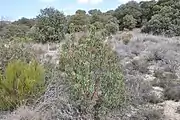Cistus laurifolius
Cistus laurifolius, commonly called laurel-leaf cistus,[1] laurel-leaved cistus[2] or laurel-leaved rock rose, is a species of highly branched flowering evergreen shrub native to some areas around the Mediterranean.
| Cistus laurifolius | |
|---|---|
 | |
| Scientific classification | |
| Kingdom: | Plantae |
| Clade: | Tracheophytes |
| Clade: | Angiosperms |
| Clade: | Eudicots |
| Clade: | Rosids |
| Order: | Malvales |
| Family: | Cistaceae |
| Genus: | Cistus |
| Species: | C. laurifolius |
| Binomial name | |
| Cistus laurifolius | |
Description
It grows 0.8–2 m (2 ft 7 in – 6 ft 7 in) high. The branches are strong and erect, with reddish bark that is easily removed in strips. The leaves are larger than in the other species of Cistus, up to 9 cm (4 in) long, lanceolate, dark green, while the underside is whitish due to trichomes. The flowering occurs in late spring (May–June), later than most rockroses.[3] It bears white flowers with a yellow spot at the base of each petal, of 4.5–5 cm diameter[4] It is widely cultivated in gardens, and has gained the Royal Horticultural Society's Award of Garden Merit.[5]
Distribution and habitat
Cistus laurifolius has a disjunct natural distribution throughout the Mediterranean Basin, being found west in Morocco, Iberia (Portugal, Spain), avoiding the wetter climate in the northwest, southern France, Corsica and Tuscany (Italy), and east in Greece and Anatolia.[4]
With the general warming of the atmosphere and the consequent withdrawal of glacial ice, flora surviving from Tertiary times could not re-establish their range in southern Europe; the new post-glacial climate was drier than that of the Tertiary. The original tropical European flora evolved into the present Mediterranean sclerophyll flora.[6][7][8] The distribution of some surviving species, such as Cistus laurifolius, shifted to wetter areas, such as the mountains.[8] Due to this, C. laurifolius is named in Spanish in its distribution area as "mountain rockrose",[8] although in the moister coastal west and northwest Iberian Peninsula, it is found at sea level.[9]
Cistus shrubland, including C. laurifolius, resprouts after fire and has seeds that germinate after fires.[10]
Phylogeny
Cistus laurifolius belongs to the white and whitish pink flowered clade of Cistus species.
| Species-level cladogram of Cistus species. | ||||||||||||||||||||||||||||||||||||||||||||||||||||||||||||||||||||||||||||||||||||||||||||||||||||||||||||||
| ||||||||||||||||||||||||||||||||||||||||||||||||||||||||||||||||||||||||||||||||||||||||||||||||||||||||||||||
| Species-level cladogram of Cistus species, based on plastid and nuclear DNA sequences.[11][12][13][14] |
Gallery
 Laurel-leaf cistus in its ecosystem.
Laurel-leaf cistus in its ecosystem. General view of the shrub.
General view of the shrub. Young branches with the large leaves.
Young branches with the large leaves. The fruits are capsules, with dehiscence revealing seeds within.
The fruits are capsules, with dehiscence revealing seeds within.
Subtaxa
References
- "Cistus laurifolius". Germplasm Resources Information Network. Agricultural Research Service, United States Department of Agriculture. Retrieved 16 January 2018.
- BSBI List 2007 (xls). Botanical Society of Britain and Ireland. Archived from the original (xls) on 2015-06-26. Retrieved 2014-10-17.
- Filippi, Olivier (2007). Pour un jardin sans arrosage (For a garden without irrigation). Arles: Actes Sud. p. 207. ISBN 978-2-7427-6730-4.
- "Cistus laurifolius" (PDF). Flora Iberica. 3: 331. Retrieved 21 March 2022.
- http://apps.rhs.org.uk/plantselector/plant?plantid=430
- John W. Harshberger (1926). "Mediterranean Garigue and Macchia (first page)". Proceedings of the American Philosophical Society. 65 (1): 56–63. JSTOR 984338.
- Fernández-Mazuecos, M.; Vargas, P. (2010). "Ecological rather than geographical isolation dominates Quaternary formation of Mediterranean Cistus species". Molecular Ecology. 19 (7): 1381–1395. doi:10.1111/j.1365-294x.2010.04549.x. PMID 20196815. S2CID 19450012.
- Beatriz Guzmán; Pablo Vargas (2005). "Systematics, character evolution, and biogeography of Cistus L. (Cistaceae) based on ITS, trnL-trnF, and matK sequences" (PDF). Molecular Phylogenetics and Evolution. 37 (3): 644–660. doi:10.1016/j.ympev.2005.04.026. PMID 16055353.
- Antonio Rigueiro Rodríguez; Fco. Javier Silva-Pando. "Aportaciones A La Flora De Galicia, I." (PDF). Anales Jard. Bot. Madrid. 40 (2): 385–395.
- R. Tárrega; E. Luis-Calabuig; I. Alonso (1997). "Space-time heterogeneity in the recovery after experimental burning and cutting in a Cistus laurifolius shrubland". Plant Ecology. 129 (2): 179–187. doi:10.1023/A:1009728317705. S2CID 1870517. Archived from the original on 2012-07-09. Retrieved 2012-05-10.
- Guzmán, B. & Vargas, P. (2005). "Systematics, character evolution, and biogeography of Cistus L. (Cistaceae) based on ITS, trnL-trnF, and matK sequences". Molecular Phylogenetics and Evolution. 37 (3): 644–660. doi:10.1016/j.ympev.2005.04.026. PMID 16055353.
- Guzmán, B. & Vargas, P. (2009). "Historical biogeography and character evolution of Cistaceae (Malvales) based on analysis of plastid rbcL and trnL-trnF sequences". Organisms Diversity & Evolution. 9 (2): 83–99. doi:10.1016/j.ode.2009.01.001.
- Guzman, B.; Lledo, M.D. & Vargas, P. (2009). "Adaptive Radiation in Mediterranean Cistus (Cistaceae)". PLOS ONE. 4 (7): e6362. Bibcode:2009PLoSO...4.6362G. doi:10.1371/journal.pone.0006362. PMC 2719431. PMID 19668338.
- Civeyrel, Laure; Leclercq, Julie; Demoly, Jean-Pierre; Agnan, Yannick; Quèbre, Nicolas; Pélissier, Céline & Otto, Thierry (2011). "Molecular systematics, character evolution, and pollen morphology of Cistus and Halimium (Cistaceae)". Plant Systematics and Evolution. 295 (1–4): 23–54. doi:10.1007/s00606-011-0458-7. S2CID 21995828.
- "Tropicos.org".